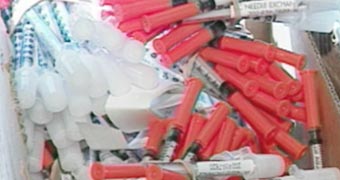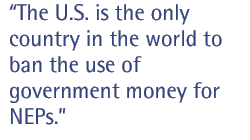
Preventing the transmission of HIV by giving clean needles to drug addicts -- one of the highest risk groups for infection -- has been a controversial issue for more than two decades in the United States. Does needle exchange bring down HIV infection rates? What does the scientific evidence show? Here is an overview.
What are needle-exchange programs?

Needle-exchange programs, or NEPs, are community-based initiatives that allow intravenous (IV) drug users to exchange used syringes for clean, sterile ones in an effort to stem the spread of HIV/AIDS, hepatitis B and other blood-borne pathogens. In addition to providing clean needles, NEPs generally provide HIV/AIDS education, testing and condoms, as well as abuse treatment referrals.
As a group, IV drug users -- who on average are estimated to inject themselves 1,000 times per year -- are at high risk of HIV/AIDS infection. One quarter of America's estimated 2 million+ IV drug users have HIV/AIDS, according to the CDC. In 2004, IV drug users accounted for 12 percent of all new HIV infections. Women and minorities in particular are vulnerable to HIV infection via IV drug use. (See chart below.) And the most vulnerable are newborn and nursing children -- IV drug use is the root cause of over half of all HIV infections among children: The CDC estimates that 4,852 of the 9,443 children under the age of 13 living with AIDS in 2004 were born to mothers who either injected drugs themselves or had sex with an IV drug user.
Percentage of people living with AIDS infected by injection drug use
Race/ethnicity | Men | Women |
White | 10% | 40% |
Black | 29% | 32% |
Hispanic | 28% | 33% |
Asian/Pacific Islander | 9% | 16% |
American Indian/Alaska Native | 17% | 39% |
Source: Centers for Disease Control (CDC), Cases of HIV Infections and AIDS in the United States, 2004.
The History of Needle Exchange in the U.S.
Soon after NEPs appeared in Europe in the early 1980s to stem the transmission of hepatitis B and AIDS, the first illegal NEPs began to crop up in the northeastern United States. Jon Parker, a former IV drug user himself, was one of the first needle-exchange activists in the U.S. Parker explained to FRONTLINE that his impetus came from an addict who spontaneously decided to bring clean needles to an HIV/AIDS prevention meeting Parker was holding for IV drug users in New Haven, Conn. After this meeting, and having heard of the successes in Europe, Parker started the first U.S. NEP in New Haven in 1986. Although Connecticut law classified syringes as drug paraphernalia, Parker decided that actually distributing clean needles, rather than just recommending their use, would be far more effective.
By the late 1980s and early 1990s, legal and illegal NEPs were started in major urban areas, primarily on the West Coast and in New York City. Today, the Centers for Disease Control (CDC) estimates that there are nearly 200 NEPs in more than 36 states. Most are still concentrated in urban centers, where IV drug use tends to be highest and where politicians and communities are more willing to use them as a preventative tool.
Is Needle Exchange Effective?
The scientific evidence indicates yes. Seven federally funded studies during the 1990s, conducted by the Government Accountability Office (GAO), the CDC and the National Academy of Sciences among others, all reached similar conclusions that NEPs work in reducing HIV's spread among IV drug users, their partners and children, and that they do not encourage increased drug use. Furthermore, a more recent study by the World Health Organization compiled the results of over 200 such reports from around the world and came to the same conclusions. However, while most studies agree on the effectiveness of NEPs, some experts argue that it's difficult to isolate the preventative effect of providing clean needles from that of all the other services offered at most NEPs.
Despite the available evidence, political leaders in Washington -- on both sides of the aisle -- have traditionally been loath to support these programs. A ban on federal funding for NEPs has been in place since 1989. Opponents question the science behind the various reports supporting NEPs and argue that endorsing NEPs implicitly condones drugs.
Even those who agree with the scientific evidence hesitate to take a stand because the issue is too controversial. "A lot of people wanted needle exchange because of the role of dirty needles in [infecting] drug users, but the opposition to it was simply overwhelming," explained former President Bill Clinton, who declined to lift the ban on federal funding. "Politically the country wasn't ready for it."
At the local level, opponents worry that if NEPs are introduced, their towns and communities will be littered with discarded needles and will attract drug users.
Obstacles to NEPs
According to Human Rights Watch, the U.S. is the only country in the world to ban the use of government money for NEPs. Because of the controversy, private non-profits and some state and local governments have been the main sources of funding.
However, NEPs face other legal and regulatory hurdles on the state and city level. Forty-seven states continue to classify syringes as drug paraphernalia, making them illegal to buy or own without a prescription.
And on the international level, Congress and the Bush administration have extended the federal funding ban to any projects receiving funds from the President's Emergency Plan for AIDS Relief (PEPFAR). Critics argue that this stance is especially dangerous in countries such as Vietnam, where the spread of HIV/AIDS is primarily driven by IV drug use.
Some members of Congress, such as Mark Souder (R-Ind.), are urging the administration to go beyond PEPFAR and ban any federal funds from supporting NEPs abroad. In a February 2005 letter to Secretary of State Condoleezza Rice and UNAIDS Administrator Andrew Natsios, Souder and House Committee for Government Reform Chair Tom Davis (R-Va.) requested documentation of USAID-funded organizations that might be supporting needle-exchange programs, which the congressmen argue is in violation of U.N. accords against drug use. They requested the documents for a subcommittee hearing later that month on harm reduction, during which Souder argued that a drug user's lifestyle is "the result of addiction, mental illness, or other conditions that should and can be treated rather than accepted as normal, healthy behaviors." An April 11, 2006, follow-up letter to Secretary Rice indicated that the congressmen had still not received all of the documents they had requested.

